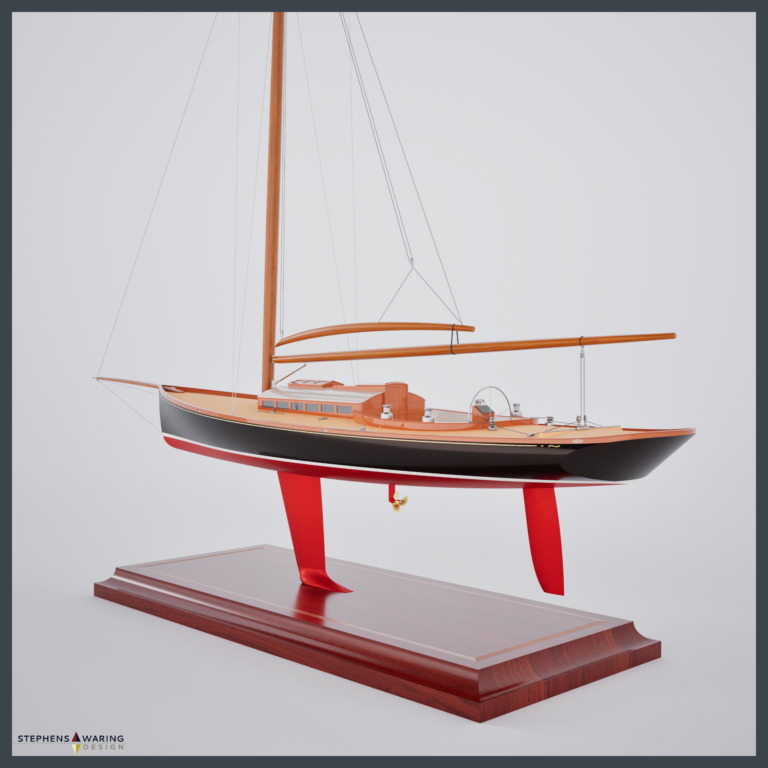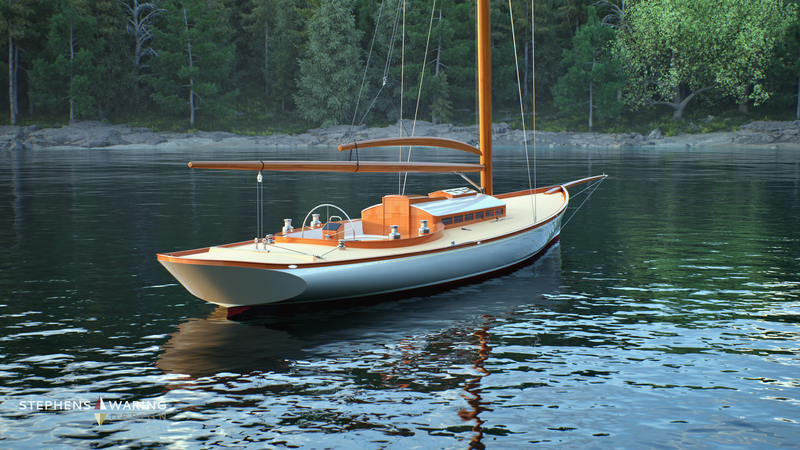Impracticality In Its Most Beautiful Form
I’d be very interested to hear what our readers think of this. It come straight off the Stephens Waring Yacht Design website.
My first reaction was perhaps a little cynical. Draw some long overhangs and a few sexy curves. Hang a deep fin and a big bulb off the bottom. Put a gaff rig with a little topsail aloft to milk the handicap system and call it a modern classic. Sounds a little inauthentic. However, anything that might stem the relentless tide of boats shaped like inflatable sand shoes, filling up our marinas is definitely worth a look.
53-FT BEAUJOLAIS
Beaujolais was a fun doodle we did for a long-time client. She’s the outgrowth of a pet effort of ours, that of expanding the idea of what makes a proper Spirit of Tradition boat.
Many folks’ interpretation of a classic yacht relies on a slender hull with long overhangs and low freeboard, the way classic racing sailboats looked in the 1920’s and ‘30’s, under the influence of rating rules like the International and Universal Rules, those responsible for bringing us beautiful racing classes like the 6-Meters and 12-Meters, and the R, Q, P, and J-boats.
But there exists a much wider palette to draw from in classic and traditional craft, a palette populated by 19-century working craft like pilot cutters, oyster skiffs, lobstering craft like the Friendship sloop and the Kingston lobster boat, and also by older yachts from the late 19th century and early 20th century.
Looking at a wider set of inspirations lets us shop for hull features that allow some freedom to adopt naval architecture found in very modern racing sailboats, unlike a style constrained by the proportions of the Meter boats and Letter boats. The short waterlines and narrow beam of those boats place hydrodynamic restrictions on maximum speed, limiting sailing performance at the same time the pinched hulls limit interior accommodations.
By adopting a design inspiration that features elements also found in modern race boats, like plumb stem and broad aft sections, we’re freed from those physical restrictions and we can well deploy the advanced materials properties and construction methods available in today’s boatbuilding, allowing us to reduce weight and decrease resistance for higher performance.
Beaujolais uses the wide, shallow-hulled centerboard racing craft of late 19the century America known as “skimming dishes”. These craft were known for their great speed in light air and smooth water—and also derided for their tendency to capsize when pushed out of their comfort zone. A great battle raged in the yachting press across the Atlantic, as the European proponents of their heavy, narrow, deeply-ballasted “plank-on-edge” cutters chastised Americans for their willingness to compromise safety for speed.
Designing today we replace the centerboard with a deep, stiff ballast keel so capsize isn’t a concern. We combine the form stability of the generous beam with the stability from a modest bulb at the bottom of a deep fin, and we can design a very light, low-resistance hull with clean flat lines for easy running and high downwind speed. Modern materials let us keep it light even with the ballast keel.
Would she be a little faster if we gave up on the raked elliptical transom and went with a vertical transom and even hull chines? It’s likely. But would she be as cool-looking? Or would she look like just another modern-day racing hull?
Where many Spirit of Tradition designs would rest with the traditionally-shaped hull and classic styling on deck and mate them with a “standard” high-performance Marconi sail plan, we’ve opted to fully embrace the period piece and supply Beaujolais with an in-character gaff rig and lengthy bowsprit. Not only does this fully commit to the genre used as inspiration, it also offers some powerful advantages.
The relatively low-aspect rig will provide tremendous power with limited heeling moment when reaching, and the broad head in the gaff mainsail is a considerably more-efficient airfoil shape than a tall, narrow pointy-headed triangular sail—more lift, less drag. The common weak points of traditional gaff rigs – weak to windward, heavy weights aloft– can be deeply mitigated with modern materials. Carbon spars make the gaff easy to hoist and strike and increase stability over heavy wood. Modern tracks and roller-bearing cars for gaff heel control the sail and spars better and allow more effective mast staying. And low-stretch halyards and sail material, paired with powerful winches, allow tensioning the rig so the gaff doesn’t twist off as older gaffs are notorious for, allowing higher pointing angles.
The final advantage: in today’s classic-fleet rating systems, a gaff-rigged boat earns a substantial rating reduction compared to the same boat with a Marconi rig. So is she a rule-beater? Maybe so.
Beaujolais could be built with a more conventional rig—in fact we doodled her with a square-top main and heavily-swept spreaders as well-proven on our own boat, Zingara—and she would be a great-sailing, spectacularly-styled boat. But she would give up on that last bit of authenticity, of holding to her classic inspiration. And isn’t that what building Spirit of Tradition bots is all about, in its purest form?
LOA: 53ft 0in (16.15m)
LWL: 45ft 10in (13.97m)
BEAM: 15ft 0in (4.57m)
DRAFT: 10ft 0in (3.05m)
DISPLACEMENT: 15,000lbs (6,800Kg)
SAIL AREA: 859sq ft (80sq m)
SA/D RATIO: 22
D/LWL RATIO: 70




